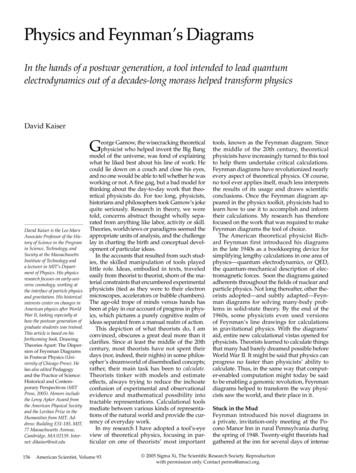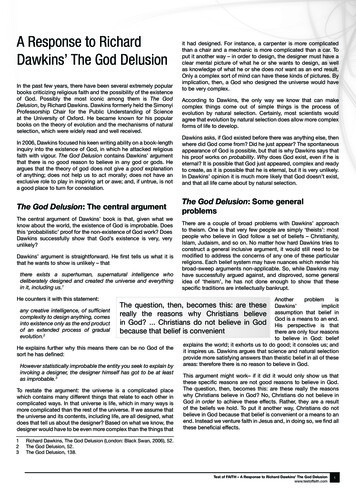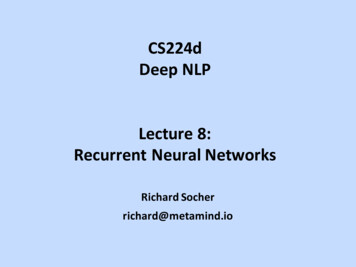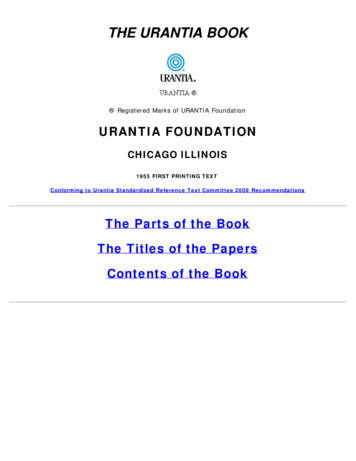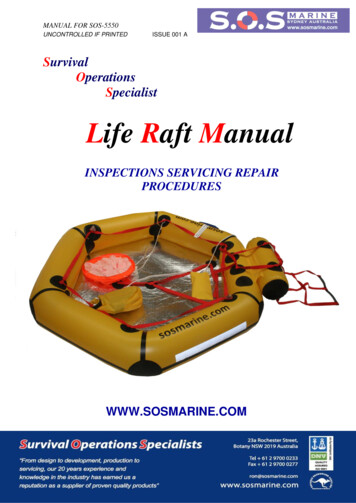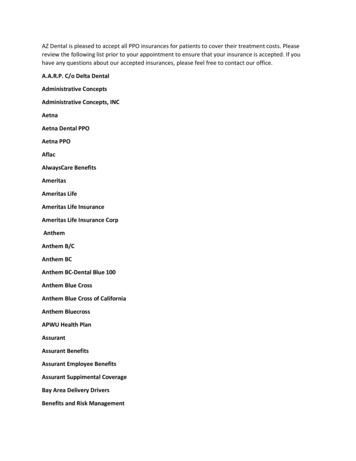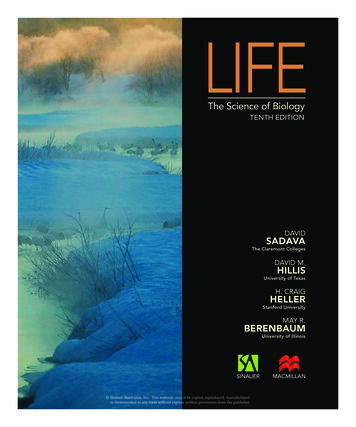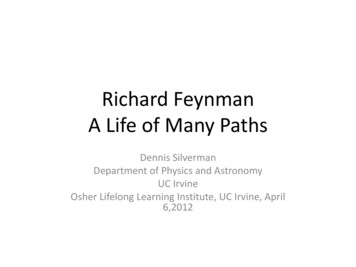
Transcription
Richard FeynmanA Life of Many PathsDennis SilvermanDepartment of Physics and AstronomyUC IrvineOsher Lifelong Learning Institute, UC Irvine, April6,2012
The Young Feynman Richard (Dick) Feynman was born May 11, 1918 in FarRockaway, Queens, NY. His parents were Jewish and from Russia and Poland. As a child he was taught by his father to take independentviewpoints on things. He repaired radios as a youth, as he could figure out what waswrong with them. He learned calculus at 15. As a senior in high school, he won the NYU Math Challenge.
Feynman’s Education and the Manhattan Project He was an undergraduate at MIT and graduated in 1939. He was a graduate student of John Wheeler’s at Princeton,where he already did advanced work on QuantumElectrodynamics (QED), and received his Ph.D. in 1942. His physics prowess was becoming well known, and he wasbrought to the Manhattan Project at Los Alamos to workwith Hans Bethe. There he became head of computing, and developedimportant codes and oversaw their parallel computing farmof ladies on calculators.
Dick and Arline He married his high school sweetheartArline Greenbaum when he received hisPh.D., although she was seriously illwith tuberculosis. She was very artistic and musical. He brought Arline to a hospital in SantaFe and would visit her on weekends.She died in 1945. This period was portrayed in the movie“Infinity” in 1996, starring and directedby Matthew Broderick.
Niels Bohr, Oppenheimer, Feynman, Enrico Fermi
Quantum Man by Lawrence M. KraussLarry KraussFeynman
Feynman and Path Integrals I read Quantum Man by Lawrence Krauss for the story of thephysics that Feynman developed and worked on. After the war, Feynman was recruited by many universitiesand decided to go to Cornell to work with Hans Bethe. There he developed his new Path Integral formulation ofQuantum Mechanics. Feynman didn’t really use this to rigorously develop hisdiagrams or rules, so we put that in an appendix. We do teach the Path Integral formulation in graduate coursesto show students how Feynman rules can be derived,however.
Light as Waves and Particles Called Photons The connection of particle and wave properties of light wasdiscovered by Max Planck. He connected the energy E of the particles of light, calledphotons, with the frequency of their wave oscillations, 𝜈, byE ℎ 𝜈 where ℎ is called Planck’s constant. This is also the relation used by Einstein in explaining thephotoelectric effect, where single electrons are ejectedfrom a solid when light hits it.
The Scale of Quantum Mechanics We will use a more convenient quantity “hbar”, whereℏ ℎ / (2 𝜋). Since ℏ usually occurs multiplied by the speed of light c, weshow their combined values in useful units:ℏ c 0.2 GeV fm 2 keV A⁰. A Fermi, fm is about the size of a proton, and a GeV (billionelectron Volts) is about the mass of the proton. An Angstrom A⁰ is about the size of an atom, and a keV is ascale for energy levels of electrons in heavy atoms.
Relativity and Quantum Mechanics The first great discoveries of combining relativity and QM wasfound by P. A. M. Dirac, which in his Dirac equation discoveredboth antiparticles, and that electrons had spin 1/2, in units ofℏ. Previous QM work showed that orbital angular momentum inatoms had only integer values, 0,1,2,3, etc. in units of ℏ, thatclassified atomic levels. The spin ½ electron, means that no two electrons can occupythe same state, and leads to the shell model of atoms, theperiodic table, chemistry, and eventually, life. This is called the Pauli Exclusion Principle.
Paul Dirac and Antiparticles with Negative EnergyThe Relativistic Energy MomentumRelation is:E² (mc²)² p²c².Note, at rest, the momentum p 0,and therefore,E mc². The negative energysolutions are those for antiparticles,since they also have the oppositecharge from the positive energysolutions.Paul Dirac
Feynman Diagrams Feynman formulated the quantum theory of interactingelectrons and electromagnetic fields called QuantumElectrodynamics in his path integral approach. The electromagnetic fields could act as particles in thephotoelectric effect, as explained by Einstein. These arecalled photons. By working many examples of processes, Feynman realized agreat simplicity: that he could formulate a set of rules forwriting the results without deriving each one. This opened up the ability to calculate to everybody. Feynman also drew diagrams that showed physically how theprocesses occurred. This has been applied to all of the new theories of current andproposed new particles and interactions.
Feynman Diagrams for QED The lowest order diagram in the strength ofthe interaction, which is the electron charge“e”. For exchange of a photon, eachconnection is given by e, and the product isscaled to the dimensionless constantα e²/ℏc 1/137.036which is called the fine structure constant. The processes in QED are an expansion inpowers of α with an extra exchanged photonfor each additional order or power of alpha.
First and Second OrderQED Feynman Diagramsfor electron-electron scattering.Second order diagrams havetwo photons exchanged.
Feynman Rules for QED Feynman’s rules give a free particle solution to the Dirac equationfor each incoming and outgoing free electron, and a solution toMaxwell’s equations for each free photon. At each vertex of an electron with a photon is a photon source J,called an interaction. Feynman propagator functions connect each exchanged photon toits current source and absorption vertexes, and each electronbetween photon. There is also a “Dirac delta function” that guarantees that energyand momentum are conserved exactly at each vertex. Because of that, energy and momentum are conserved for eachdiagram from start to finish. The oft made statement that energy can fluctuate in a processshould really be that the intermediate particles are virtual, anddon’t have the right connection of energy and momentum toescape as free particles.
Freeman Dyson, Julian Schwinger, and Sin-Itiro TomonagaFreeman Dyson showed in 1948 that Feynman’s diagramsand rules for calculation were the same as the Field Theoryapproaches of Julian Schwinger and Sin-Itiro Tomonaga.
Antiparticles as Negative Energy Solutions In these rules, Feynman interpreted the negative energy solutionsas particles moving backwards in time. This got rid of the earlier interpretation where antiparticles wereholes in a filled sea of negative energy particles that permeated allof space-time, the so-called Dirac sea. In propagation of photons between the source electron and theabsorbing electron, both time orderings of emission and absorptioncould be included relativistically, in a “propagator” function thatwas developed in Feynman’s thesis with John Wheeler. These had also been developed independently by E. C. GStueckelberg, but not exploited as Feynman did. Feynman Video “Go Somewhere Else” Hans Bethe on Feynman and Schwinger
Feynman Moves to CalTech In 1950, Feynman was offered a position at CalTech. Before going there he took a half year off to relax in Rio inBrazil, where he taught Physics and learned to play the bongodrums. From 1952 to 56 he was married to Mary Louise Bell, but thatdid not turn out to be a good match, since he worked all ofthe time. After that, on a trip to Switzerland, he met the BritishGweneth Howard, and hired her as an au pair. He married her in 1960, and they had a son Carl and anadopted daughter, Michelle.
Feynman’s Van and Family
Superfluid Helium, Superconductivity and WeakInteractions Besides particle physics, Feynman worked on SuperfluidHelium. He treated it as a “Bose-Einstein” condensate, inwhich all He atoms of zero angular momentum could be inthe same state and act alike at low temperatures as freeparticles. He also worked on Superconductivity, where he discoveredand worked on vortices as the excitations in thesuperconductor. With Murray Gell-Mann at CalTech, he formulated thetheory for the weak interactions, which was like QED, butincluding another current that violated parity maximally,called the “V-A” theory. It used only left spinning electrons,and right spinning positrons.
Feynman and Nanotechnology In 1959 Feynman gave a lecturespeculating on manipulation andbuilding machines on the atomic ormolecular scale, which is now knownas nanotechnology. The title of the talk was “There’sPlenty of Room at the Bottom”. Today we can see and move individualatoms with atomic force microscopes. He also covered microscopic datastorage, microscopic motors, andquantum engineering.
The Feynman Lectures By 1961, Feynman got very interesting in teaching, andpresenting his own unique outlook on basic physics subjects. He taught Freshman and then Sophomore physics, and hisnotes were compiled by Robert B. Leighton and MatthewSands The lectures were not only complete, but added analyses ofmany phenomena in a simple, Feynman way. You can almosthear Feynman speaking in the syntax used.
The Feynman Lectures The lectures were published as the Feynman Lectures inPhysics in three red volumes (list copied from Wikipedia): Volume 1: Mechanics, radiation and heat. Volume 2: Electromagnetism and matter. Volume 3: Quantum mechanics. Abbreviated editions:– Six Easy Pieces (1994)– Six Not-So Easy Pieces (1998)– The Very Best of the Feynman Lectures (Audio, 2005)
“The Character of Physical Law” Messenger Lectures In 1964 he went to Cornell to give seven Messenger lectures, which wererecorded on film. They are titled “The Character of Physical Law”. In 2009, Bill Gates obtained the rights to these and put them on the webfor free as “Project Tuva”. They can be viewed on Windows with specialsoftware including notes. The lectures are titled (copied from Wikipedia): The law of gravitation, an example of physical lawThe relation of mathematics to physicsThe great conservation principlesSymmetry in physical lawThe distinction of past and futureProbability and uncertainty - the quantum mechanical view ofnature Seeking new laws Start of Feynman Lecture on Quantum Mechanics
Feynman Lectures on Gravitation In 1962 to 1963, Feynman turned to Gravity, which had onlybeen dealt with classically before. He quantized gravity, with the graviton being the quantum ofthe gravitational field radiation. He laid out the Feynman rules for gravity and did the secondorder calculation, discovering the bad infinities, that have onlybeen dealt with now with supersymmetric string theory. He also realized the possibility of a zero net energy universe,which is now part of the inflation model of the start of theuniverse. His lectures at CalTech on this were not published as a bookuntil 1995.
1965 Nobel Prize inPhysicsIn 1965 the Nobel Prize inPhysics was awarded forthe development of QED toFeynman, Schwinger, andTomonaga.Feynman’s speech on thehistory of his developmentof the theory is on theNobel website.
Feynman’s House in La Mision, Baja, From the Nobel Prize
Feynman takes up Drawing Around 1962 Feynman took upart to express the deep emotionsthat he felt about nature. His drawings can be seen on thewww.museumsyndicate.comwebsite. He used the pseudonym Ofeyafter the French “au Fait”,meaning “it is done”. This one is called “Equationsand Sketches”.
Feynman Drawing
Feynman Playing Bongo Drums with Ralph Leighton
Feynman and Computing – Stephen Wolfram From 1981-85 Feynman worked on questions of computer simulation,parallel processor computation, pattern recognition, and computability ofphysics problems. He also wrote about quantum element computation. He worked on cellular automata or schemes of cellular nodes evolving intime with certain rules. He helped inspire Stephen Wolfram to program a computer to do algebra,which became the Mathematica software and company. This has expanded to the all data app called “Wolfram alpha” on iPhones,and a principal source for Siri.
The Stanford Linear Accelerator Center (SLAC)that scattered electrons off of protons at high energy.The two mile linear electronacceleratorMagnets and detectors for thescattered electrons
Frozen Pancakes and Partons SLAC was scattering electrons off ofprotons at high energy, or shortwavelength, of the virtual photonsgiven off by the deflected electrons. Feynman realized that passing aproton at high speed meant that theproton would Lorentz contract andlook like a pancake. Also, clocks in the proton wouldappear to slow down, called timedilation, so the constituents of theproton, called partons, would appearto not be interacting, and would actas free particles, frozen in place.
Scattering of Electrons by Partons via Photonseeq virtual photonq xPpartonsP protonxP The process would essentiallytake an instantaneous picture ofthe proton at high resolution,with the constituents frozen. The momentum of the partonswas along the same direction asthe proton, but with a fractionof the total momentum called x Pparton x Pproton, where x runsfrom 0 to 1.
Partons as Quarks Since the scattering was due tophotons, the amount of scattering oreffective “cross section” of the protonfor scattering, would be due to thesquare of the charge of each parton. The fractional ( 2/3 e) charge for an upquark parton, and (-1/3 e) for a downquark parton, was then revealed, andthe partons could be identified as GellMann and Zweig’s quarks. Rather than just a mathematicalunderpinning of particle symmetries,the quarks were real particles!
Parton Distribution Functions Up and down quarks in theproton forming its core are calledvalence partons (uud), and havethe parton x distributions u and din the figure (multiplied by x). Virtual gluons can also createpairs of u, d, and s quarks andantiquarks, forming a sea ofquarks, with a distributionslabeled by u and d with bars, ands. Gluons frozen in the picture ofscattering have the distribution g,which show up in stronginteraction scattering.
SLAC Nobel Prize in 1990 for Proton Structure byRichard Taylor, Jerome Friedman, and Henry Kendall
Other Discoveries of Free Particle Scattering The effective results of the free parton scatteringwere previously inferred through an abstractCurrent Algebra approach by James Bjorken at SLACbefore the results came in. So it is called FeynmanBjorken scaling. Feynman’s genius of simplicity was to see that thescattering was due to a free parton, and that thevalue for x could be derived from the scatteringenergy and momentum in a few lines. The parton distribution functions are also used inproton-proton scattering, and in all high energyprocesses.
Personally Relevant SLAC PicturesSLAC Theory conference roomthat also used to be my office asa graduate studentUCI Physics Ph.D. JonathanDorfan, who became director ofSLAC
My Thesis Advisor Sid Drell, and Former Lab Directorand Nobel Laureate Burton Richter (1976). The textby Bjorken and Drell became the standard text forFeynman Diagrams and the Rules of QED.As a grad student, you worked hard or else.
Feynman Diagrams Today Today, Feynman Diagrams areused for Weak, Electromagneticand Strong interactions at highenergy. They can be calculated to highorder using formulas based on thepreceding order. They are now generated bycomputer and calculated bycomputer. Monte Carlo programs are writtenfor various experiments thatcalculate the number of eventsthat are expected in anexperiment from the diagrams.Higgs from gluon fusion
Automated Theory to Experiment via Feynman Diagrams
The Challenger Space Shuttle Rogers Commission In January 18, 1986 the space shuttle Challenger explodedwhile in the booster rocket phase, and Feynman wasappointed to the Rogers Commission to examine the causeand increase the safety of the space shuttle. The solid booster rocket was actually put together fromseveral pieces, sealed by two O rings around thecircumference. Engineers had pointed out problems with this tomanagement, but they delayed in instituting fixes.
Feynman’s Demonstration But the day of the launch thetemperature was as low as 8⁰ F. In the Congressional hearing inFebruary, Feynman rustled together asmall O ring and ice to show how itwould freeze and not expand to sealthe joints. Feynman accepted this responsibilityeven though he was already very illwith cancer.
Feynman’s Report on Safety and Management The joints also were pulled apart by twistingand expansion of the booster segments. This caused the escaping flame to burn thelower booster attachment, open a hole to thehydrogen tank in the external fuel tank, andthe booster to detach, resulting in disaster. Feynman also wrote an appendix F to thereport where he discussed problems withestimating safety levels and examined thesafety of all of the systems of the shuttle. He also pointed out that management wasalways increasing the safety levelsdetermined by engineers by factors of ahundred or a thousand.
How Feynman Viewed Physics:as a lot of interconnected subjects that affected eachother.
Feynman’s Departure and Legacy Feynman contracted a rare cancer in 1979.In 1987 he had a recurrence and another rare cancer.Despite this he kept working out of interest.He died in on Feb. 15, 1988 at the age of 69.Feynman on Science and Living With UncertaintyIt is clear that Feynman inspired a spirit of independentthinking in all fields, and a spirit of striving for and finding thesimplest ways of understanding and explaining science.
Feynman Web Sources Googling Feynman will turn up many sites devoted tohim as well as Wikipedia articles and the Wikiquotes site. There are also interviews with him on YouTube. We already mentioned the Messenger lectures on theTuva Project site. On TED there are lectures from a conference from peoplewho knew Feynman. CalTech Photo Archives has 277 pictures of Feynman (payfor use) Also on the site where Gell-Mann has 200 shortbiographical segments, there are comments on Feynmanas well.
Books by and about Feynman There are many books that he wrote and that were writtenabout him that are shown on the next slides. Feynman was agreat story teller. Alan Alda studied Feynman and gave a play “QED” in 2001. In 2005 there was an opera called “Feynman”. In 2005 there was also a Feynman stamp, above.
BOOKS BY FEYNMAN
BOOKS ABOUT FEYNMAN
My Feynman Stories Feynman at HughesFeynman and safes at Los AlamosFeynman at AspenDick O’Fey’s talks to UCI undergradsFeynman, Drell, Gell-MannTalk on scheme of physicsNegative Probabilities
Technical Appendices
Technical Appendix: The Action in Physics Difficult classical physics problems are solved by minimizing the“action” S which is defined as the sum (integral) over time, over apath, of the kinetic energy (K.E.) minus the potential energy (P.E.):S ( K.E. ‒ P.E.) t Traveling on a level surface with no P.E., for a car, say,S K.E. · time So the principal of least action for a drive means minimizing thetime it takes, something we intuitively do all the time. For QED, the action S includes includes the interaction of theelectron current eJ with the electromagnetic field A:eJ·A, where e is the charge of the electron.
Technical Appendix: The Sum over Paths, or Path Integral In Quantum Mechanics, a particle is also a wave, which travels overmany paths. Feynman looked at QM by summing over all possible paths that aparticle could take, allowing wavelike interference by using as aphase the action S/ℏ on that path, in B. For those paths for which Sis very near its minimum, they all have almost the same value of S,and they interfere constructively, thereby giving the classical path,and explaining the classical Principle of Least Action, which isequivalent to Newton’s Law, but used for complex problems.Classical PathQuantum Paths
The Generation of Feynman Graphs in QED The action enters in an exponential function as a phase:exp( i S / ℏ ). When the exp function is expanded it is a series in allpowers in S, or all powers of the interaction vertex eJ·A. Thus all orders of photon exchange are included. Since each photon exchange has two currents, one at eachend, it is a series in order of e² or α e²/ℏc. Since α issmall it is called a perturbation series, and only a few termsare usually needed. A produced photon would have just one current eJ·A, and Awould be the photon’s outgoing wave function.
Technical Appendix: Removing the infinities The higher order diagrams in QED had mild infinities. Feynman first formulated a high energy cutoff, that could bedue to unknown physics at very short distances. He then showed that some infinities could be cancelled, andothers absorbed by replacing the bare or input masses andcharges by their physical values. He published this in 1949. His colleague and friend Freeman Dyson showed that thiscould work to all orders.
Technical Appendix: Parton Math and Scaling With the proton having momentum p, the parton having momentum xp,and the photon having momentum q, the scattered parton has finalmomentum (xp q). The condition that it be a free particle is (q x p)² m². Multiplying this out we have q² 2 x p q x² p² m² Now p q m𝜈 m (E-E’) (in the lab frame), where E is the incomingelectron energy, and E’ is the outgoing electron energy. At large q² and ν we ignore p² and m², giving q² 2xp q 0, or: q² 2xm𝜈 0. therefore, x -q² /(2mν) , the Bjorken or Feynman x! With k the incoming electron momentum, and k’ the outgoing electron’s , q² (k – k’)² -2k·k’ -2 E E’ (1‒ cos 𝜃) where 𝜃 is the electronscattering angle. Experiments summing over all hadron final states of the same x shouldhave the same result, even for different values of q² and 𝜈, as long as theygive the same ratio x. This is called Feynman-Bjorken scaling.
I read Quantum Man by Lawrence Krauss for the story of the physics that Feynman developed and worked on. After the war, Feynman was recruited by many universities and decided to go to Cornell to work with Hans Bethe. There he developed his new Path In
